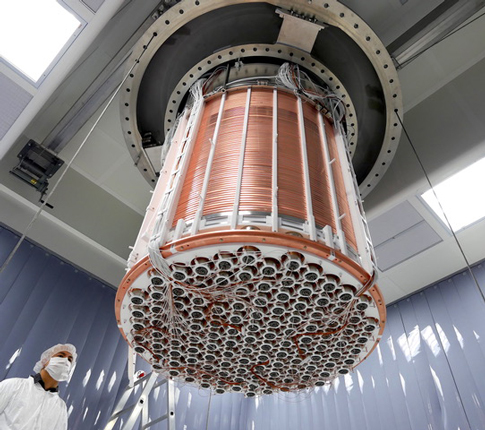
Scientists from the international XENON collaboration announced today that data from their XENON1T, the world's most sensitive dark matter experiment, show a surprising excess of events.
The scientists do not claim to have found dark matter. Instead, they say to have observed an unexpected rate of events, the source of which is not yet fully understood. The signature of the excess is similar to what might result from a tiny residual amount of tritium (a hydrogen atom with one proton and two neutrons), but could also be a sign of something more exciting—such as the existence of a new particle known as the solar axion or the indication of previously unknown properties of neutrinos.
XENON1T was operated deep underground at the INFN Laboratori Nazionali del Gran Sasso in Italy, from 2016 to 2018. It was primarily designed to detect dark matter, which makes up 85% of the matter in the universe. So far, scientists have only observed indirect evidence of dark matter, and a definitive, direct detection is yet to be made. So-called WIMPs (Weakly Interacting Massive Particles) are among the theoretically preferred candidates, and XENON1T has thus far set the best limit on their interaction probability over a wide range of WIMP masses. In addition to WIMP dark matter, XENON1T was also sensitive to different types of new particles and interactions that could explain other open questions in physics. Last year, using the same detector, these scientists published in Nature the observation of the rarest nuclear decay ever directly measured.
The XENON1T detector was filled with 3.2 tonnes of ultra-pure liquefied xenon, 2.0 t of which served as a target for particle interactions. When a particle crosses the target, it can generate tiny signals of light and free electrons from a xenon atom. Most of these interactions occur from particles that are known to exist. Scientists therefore carefully estimated the number of background events in XENON1T. When data of XENON1T were compared to known backgrounds, a surprising excess of 53 events over the expected 232 events was observed.
This raises the exciting question: where is this excess coming from?
One explanation could be a new, previously unconsidered source of background, caused by the presence of tiny amounts of tritium in the XENON1T detector. Tritium, a radioactive isotope of hydrogen, spontaneously decays by emitting an electron with an energy similar to what was observed. Only a few tritium atoms for every 1025 (10,000,000,000,000,000,000,000,000 !!) xenon atoms would be needed to explain the excess. Currently, there are no independent measurements that can confirm or disprove the presence of tritium at that level in the detector, so a definitive answer to this explanation is not yet possible.
More excitingly, another explanation could be the existence of a new particle. In fact, the excess observed has an energy spectrum similar to that expected from axions produced in the Sun. Axions are hypothetical particles that were proposed to preserve a time-reversal symmetry of the nuclear force, and the Sun may be a strong source of them. While these solar axions are not dark matter candidates, their detection would mark the first observation of a well-motivated but never observed class of new particles, with a large impact on our understanding of fundamental physics, but also on astrophysical phenomena. Moreover, axions produced in the early universe could also be the source of dark matter.
Alternatively, the excess could also be due to neutrinos, trillions of which pass through your body, unhindered, every second. One explanation could be that the magnetic moment (a property of all particles) of neutrinos is larger than its value in the Standard Model of elementary particles. This would be a strong hint to some other new physics needed to explain it.
Of the three explanations considered by the XENON collaboration, the observed excess is most consistent with a solar axion signal. In statistical terms, the solar axion hypothesis has a significance of 3.5 sigma, meaning that there is about a 2 / 10,000 chance that the observed excess is due to a random fluctuation rather than a signal. While this significance is fairly high, it is not large enough to conclude that axions exist. The significance of both the tritium and neutrino magnetic moment hypotheses corresponds to 3.2 sigma, meaning that they are also consistent with the data.
XENON1T is now upgrading to its next phase–XENONnT–with an active xenon mass three times larger and a background that is expected to be lower than that of XENON1T. With better data from XENONnT, the XENON collaboration is confident it will soon find out whether this excess is a mere statistical fluke, a background contaminant, or something far more exciting: a new particle or interaction that goes beyond known physics.
The XENON collaboration comprises 163 scientists from 28 institutions across 11 countries.
The XENON spokesperson
Prof. Elena Aprile, Columbia University, New York, US
This email address is being protected from spambots. You need JavaScript enabled to view it.
Tel. +39 3494703313 Tel. +1 212 854 3258
LNGS-INFN Public Affairs | Roberta Antolini
This email address is being protected from spambots. You need JavaScript enabled to view it.
+39 0862 437216
REIS - 17.06.2020


